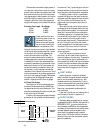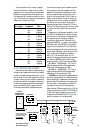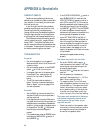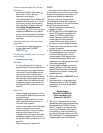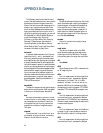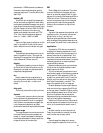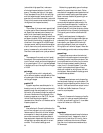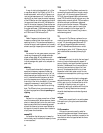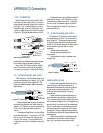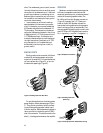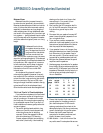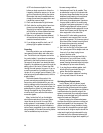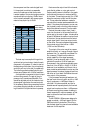30
(also called a high-pass filter) reduces or
eliminates frequencies below its cutoff fre-
quency. There are also high-cut (low-pass)
filters, bandpass filters (which cut both high
and low frequencies but leave a band of fre-
quencies in the middle untouched), and notch
filters (which remove a narrow band but leave
the high and low frequencies alone).
frequency
The number of times an event repeats itself
in a given period. Sound waves and the electri-
cal signals that represent sound waves in an
audio circuit have repetitive patterns that
range from a frequency of about 20 repetitions
per second to about 20,000 repetitions per sec-
ond. Sound is the vibration or combination of
vibrations in this range of 20 to 20,000 repeti-
tions per second, which gives us the sensation
of pitch, harmonics, tone, and overtones. Fre-
quency is measured in units called Hertz (Hz).
One Hertz is one repetition or cycle per second.
gain
The measure of how much a circuit ampli-
fies a signal. Gain may be stated as a ratio of
input to output values, such as a voltage gain of
4, or a power gain of 1.5, or it can be expressed
in decibels, such as a line amplifier with a gain
of 10 dB.
gain stage
An amplification point in a signal path,
within either a system or a single device. Over-
all system gain is distributed between the
various gain stages.
graphic EQ
A graphic equalizer uses slide pots for its
boost/cut controls, with its frequencies evenly
spaced through the audio spectrum. In a per-
fect world, a line drawn through the centers of
the control shafts would form a graph of the
frequency response curve. Get it? Or, the posi-
tions of the slide pots give a graphic
representation of boost or cut levels across the
frequency spectrum.
ground
Also called earth. Ground is defined as the
point of zero voltage in a circuit or system, the
reference point from which all other voltages
are measured. In electrical systems, ground
connections are used for safety purposes, to
keep equipment chassis and controls at zero
voltage and to provide a safe path for errant
currents. This is called a safety ground.
Maintaining a good safety ground is always
essential to prevent electrical shock. Follow
manufacturer’s suggestions and good electrical
practices to ensure a safely grounded system.
Never remove or disable the grounding pin on
the power cord.
In computer and audio equipment, tiny
currents and voltages can cause noise in the
circuits and hamper operation. In addition to
providing safety, ground provisions in these
situations serve to minimize the pickup, detec-
tion and distribution of these tiny noise signals.
This type of ground is often called technical
ground.
Quality audio equipment is designed to
maintain a good technical ground and also op-
erate safely with a good safety ground. If you
have noise in your system due to technical
grounding problems, check your manual for
wiring tips or call technical support. Never dis-
able the safety ground to reduce noise problems.
ground loop
A ground loop occurs when the technical
ground within an audio system is connected to
the safety ground at more than one place. Two
or more connections will allow tiny currents to
flow in the loops created, possibly inducing
noise (hum) in the audio system. If you have
noise in your system due to ground loops,
check your manual for wiring tips or call tech-
nical support. Never disable the safety ground
to reduce noise problems.
headroom
The difference between nominal operating
level and peak clipping in an audio system. For
example, a mixer operating with a nominal line
level of +4 dBu and a maximum output level of
+22 dBu has 18 dB of headroom. Plenty of
room for surprise peaks.
Hertz
The unit of measure for frequency of oscilla-
tion, equal to 1 cycle per second. Abbreviated
Hz. KHz (pronounced “kay-Hertz”) is an abbre-
viation for kilohertz, or 1000 Hertz.
Hz
See Hertz.
impedance
The AC resistance/capacitance/inductance
in an electrical circuit, measured in ohms. In
audio circuits (and other AC circuits) the im-
pedance in ohms can often be very different
than the circuit resistance as measured by a
DC ohmmeter.





